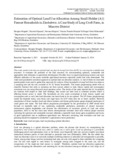Please use this identifier to cite or link to this item:
https://cris.library.msu.ac.zw//handle/11408/1706Full metadata record
| DC Field | Value | Language |
|---|---|---|
| dc.contributor.author | Mugabe, Douglas | - |
| dc.contributor.author | Chipunza, Nyasha | - |
| dc.contributor.author | Mupaso, Norman | - |
| dc.contributor.author | Munyati, Vincent Tinashe | - |
| dc.contributor.author | Makarudze, Fungai Violet | - |
| dc.date.accessioned | 2016-07-20T13:50:05Z | - |
| dc.date.available | 2016-07-20T13:50:05Z | - |
| dc.date.issued | 2014 | - |
| dc.identifier.issn | 1916-9752 | - |
| dc.identifier.uri | http://www.ccsenet.org/journal/index.php/jas/article/viewFile/29997/19278 | - |
| dc.identifier.uri | http://hdl.handle.net/11408/1706 | - |
| dc.description | Full-text | en_US |
| dc.description.abstract | This study aimed to develop an optimal land use plan for Long Croft farm (LCF) by assessing the available land resources. It evaluates the potential of the land resources for recommending optimum, sustainable and appropriate land utilisation in agriculture development. Possible ways in improving farming systems and more efficient utilization of the scarce available agricultural resources especially arable land were determined. The study used quantitative analytical approach in optimal land use allocation analysis. A total of thirty six structured questionnaires were used to gather data necessary for analysis. Every household at Long Croft farm was taken as a sampling unit and the area consisted of 36 A1 farmer households. The Linear programming model with an objective function that seeks to maximise net farm income subject to land, labour, capital and consumption constraints was run using Microsoft excel premium solver. The results of the study showed that A1 households are insecure with respect to their land holdings; they cannot use their land as collateral security which is affecting farmer access to credit. The households are also much constrained in land, labour, capital and consumption and as such their land allocation has been found to be not optimal. The LP (linear programming) model has depicted maize, soya beans and sugar beans for LCF when they are no factor markets. However introduction of factor markets (land and labour markets) and farmer performance groups depicted production of small grains and maize. The land reform programme promulgated by the government in 2000 should have focused on equitable right of use, optimising sustainable production, protection of natural resources/ environment against degradation and increase the effectiveness of economic growth of rural and urban population. Most of the fast track land reform developmental activities were done without proper resource surveying for optimum and sustainable resource utilization, especially land, hence great competition and losses of good agricultural uses to inefficient agricultural uses. Resource surveying, land evaluation and land use planning should be employed in Zimbabwe’s agriculture to boast production. | en_US |
| dc.language.iso | en | en_US |
| dc.publisher | Canadian Center of Science and Education | en_US |
| dc.relation.ispartofseries | Journal of Agricultural Science;Vol. 6, No. 2. | - |
| dc.subject | Land, land use types, land use planning, optimal allocation | en_US |
| dc.title | Estimation of optimal land use allocation among small holder (A1) farmer households in Zimbabwe. A case study of Long Croft Farm, in Mazowe District | en_US |
| dc.type | Article | en_US |
| item.languageiso639-1 | en | - |
| item.fulltext | With Fulltext | - |
| item.grantfulltext | open | - |
| item.openairetype | Article | - |
| item.openairecristype | http://purl.org/coar/resource_type/c_18cf | - |
| item.cerifentitytype | Publications | - |
| Appears in Collections: | Research Papers | |
Files in This Item:
| File | Description | Size | Format | |
|---|---|---|---|---|
| MUGABE DOUGLAS.pdf | 212.78 kB | Adobe PDF |  View/Open |
Page view(s)
164
checked on Dec 8, 2025
Download(s)
40
checked on Dec 8, 2025
Google ScholarTM
Check
Items in MSUIR are protected by copyright, with all rights reserved, unless otherwise indicated.



